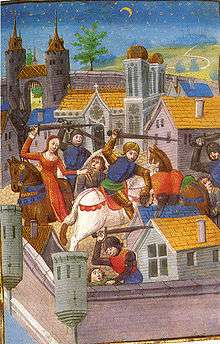Triaria

Triaria (also known as Junia Calvina Milonia Caecena Alba Terentia[1]) was the second wife of Lucius Vitellius the younger (the brother of emperor Aulus Vitellius), in the 1st century CE.
Life
She was the first-born daughter and among the children of Aemilia Lepida and Marcus Junius Silanus Torquatus, a member of the Junii Silani, a family of Ancient Rome. Her maternal grandparents were the princess Julia the Younger and consul Lucius Aemilius Paullus. Through her maternal grandparents she was a descendant of Roman Emperor Augustus, noble woman Scribonia, statesman Marcus Vipsanius Agrippa and consul Lucius Aemilius Lepidus Paullus (brother of the triumvir Marcus Aemilius Lepidus).
She married Lucius Vitellius the Younger, brother of the future Roman Emperor Vitellius, though they divorced before 49. In 48, she was falsely accused by Empress Agrippina the Younger and her former father-in-law of open affection with her brother Lucius Junius Silanus Torquatus. Calvina was exiled from Italy in early 49 and her brother committed suicide. After March 59, when Agrippina the Younger was murdered, her son Emperor Nero brought Calvina back from exile. Tacitus describes her as "attractive but shameless". Suetonius, Vespasian 23, implies that Junia Calvina was still living in 79. The date of her death is unknown but she was probably the last living descendant of Augustus in the Flavian dynasty.
She is mentioned on the funeral monument of her favourite slavewoman, Tyrannis, in Tibur:[2]
According to Tacitus, when former praetor Marcus Plancius Varus implied treasonable behaviour by Dolabella, she terrified the City Prefect, Titus Flavius Sabinus, warning him not to seek a reputation for clemency by endangering the Emperor.,[3][4]
She was accused of wearing a soldier's sword and behaving with insolent cruelty after the capture of the town of Tarracina.[5]
In On Famous Women, Boccaccio praised Triaria for her bravery. [6][7][8] An early French manuscript of this work[9] contains a plate f. 63v (captioned Miniature showing a bloody slaughter inside a walled city, with Triaria prominent among the wounded warriors.) which may refer to the sack of Tarracina.
See also
Notes
- ↑ Prosopographia Imperii Romani saeculi I, II et III, E. Groag, A. Stein, L. Petersen (edd.), Berlin, 1933.
- ↑ CIL XIV, 3661.
- ↑ Crime and Punishment in Ancient Rome, Richard A Bauman, Routledge, 2005, ISBN 0-415-11375-X, p86
- ↑ The Histories, Gaius Cornelius Tacitus, Oxford University Press, 2001, ISBN 0-19-283958-6, p94.
- ↑ ibid p164.
- ↑ De claris mulieribus, Giovanni Boccaccio, trans. as Famous Women by Virginia Brown, Harvard University Press, 2001, ISBN 0-674-00347-0, Ch 94.
- ↑ De las mujeres illustres en romance, Johan Boccaccio, Zaragoza, Paulo Hurus, Alemán de Constancia, 1494.
- ↑ Original Boccaccio text (in Latin)
- ↑ Des cleres et nobles femmes, ca. 1450, Spencer Collection Ms. 033, NYPL
External links
- De memorailibus et claris mulieribus: aliquot diversorum scriptorum opera, Ravisius, Johannes (Ed.)
- Boccaccio on Triaria (in Spanish)
Primary sources
| Wikisource has original text related to this article: |
- Gaius Cornelius Tacitus Historiae ii.63, iii.76-77
- Continuité gentilice et continuité sénatoriale dans les familles sénatoriales romaines à l'époque impériale, 2000